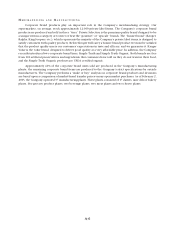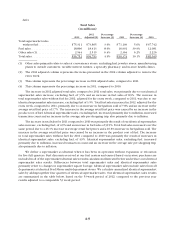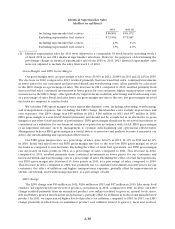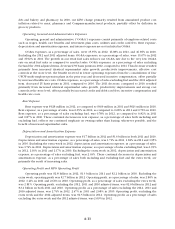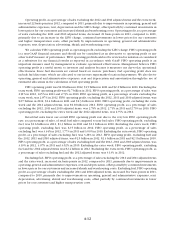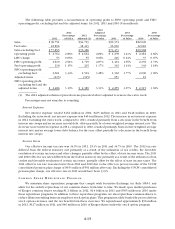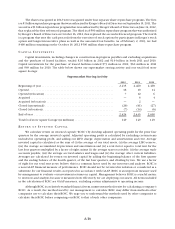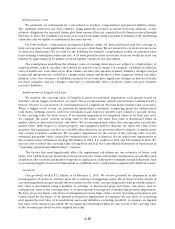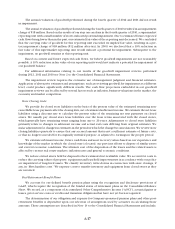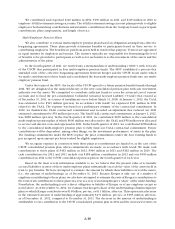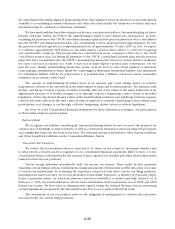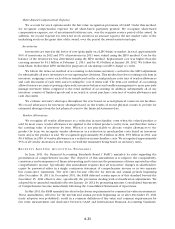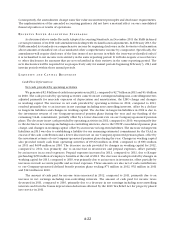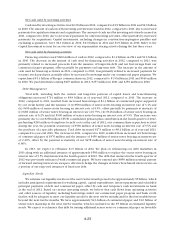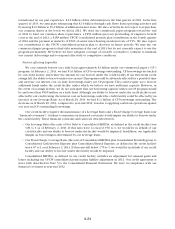Kroger 2012 Annual Report Download - page 72
Download and view the complete annual report
Please find page 72 of the 2012 Kroger annual report below. You can navigate through the pages in the report by either clicking on the pages listed below, or by using the keyword search tool below to find specific information within the annual report.
A-14
The shares reacquired in 2012 were reacquired under four separate share repurchase programs. The first
is a $1 billion repurchase program that was authorized by Kroger’s Board of Directors on September 15, 2011. The
second is a $1 billion repurchase program that was authorized by Kroger’s Board of Directors on June 14, 2012,
that replaced the first referenced program. The third is a $500 million repurchase program that was authorized
by Kroger’s Board of Directors on October 16, 2012, that replaced the second referenced program. The fourth
is a program that uses the cash proceeds from the exercises of stock options by participants in Kroger’s stock
option and long-term incentive plans as well as the associated tax benefits. As of February 2, 2013, we had
$466 million remaining on the October 16, 2012 $500 million share repurchase program.
CA P I T A L I N V E S T M E N T S
Capital investments, including changes in construction-in-progress payables and excluding acquisitions
and the purchase of leased facilities, totaled $2.0 billion in 2012 and $1.9 billion in both 2011 and 2010.
Capital investments for the purchase of leased facilities totaled $73 million in 2012, $60 million in 2011
and $38 million for 2010. The table below shows our supermarket storing activity and our total food store
square footage:
Supermarket Storing Activity
2012 2011 2010
Beginning of year .............................................. 2,435 2,460 2,469
Opened ...................................................... 18 10 14
Opened (relocation) ............................................ 7 12 6
Acquired ..................................................... — 6 4
Acquired (relocation) ........................................... — 2 —
Closed (operational) ............................................ (29) (41) (27)
Closed (relocation) ............................................. (7) (14) (6)
End of year ................................................... 2,424 2,435 2,460
Total food store square footage (in millions) ......................... 149 149 149
RE T U R N O N I N V E S T E D C A P I T A L
We calculate return on invested capital (“ROIC”) by dividing adjusted operating profit for the prior four
quarters by the average invested capital. Adjusted operating profit is calculated by excluding certain items
included in operating profit, and adding our LIFO charge, depreciation and amortization and rent. Average
invested capital is calculated as the sum of (i) the average of our total assets, (ii) the average LIFO reserve,
(iii) the average accumulated depreciation and amortization and (iv) a rent factor equal to total rent for the
last four quarters multiplied by a factor of eight; minus (i) the average taxes receivable, (ii) the average trade
accounts payable, (iii) the average accrued salaries and wages and (iv) the average other current liabilities.
Averages are calculated for return on invested capital by adding the beginning balance of the first quarter
and the ending balance of the fourth quarter, of the last four quarters, and dividing by two. We use a factor
of eight for our total rent as we believe this is a common factor used by our investors and analysts. ROIC is
a non-GAAP financial measure of performance. ROIC should not be reviewed in isolation or considered as a
substitute for our financial results as reported in accordance with GAAP. ROIC is an important measure used
by management to evaluate our investment returns on capital. Management believes ROIC is a useful metric
to investors and analysts because it measures how effectively we are deploying our assets. All items included
in the calculation of ROIC are GAAP measures, excluding certain adjustments to operating income.
Although ROIC is a relatively standard financial term, numerous methods exist for calculating a company’s
ROIC. As a result, the method used by our management to calculate ROIC may differ from methods other
companies use to calculate their ROIC. We urge you to understand the methods used by other companies to
calculate their ROIC before comparing our ROIC to that of such other companies.




